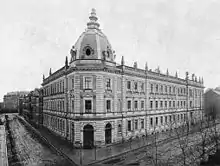Eberhard Westhofen (1820 1892) was a German architect and building official. He worked as a country architect in Cologne until 1847 and then as 'city architect' in Düsseldorf.
Life
In November 1850 he married Johanna, a née von Thenen[1] and moved into a flat on Bolkerstraße.[2] In 1854 he moved to Wasserstraße in Schwanenspiegel.[3] In 1888 Westhofen retired and received the Order of the Red Eagle IV. Class.[4] Last residence at Grabbeplatz 2, Eberhard Westhofen died in 1892.
Realisations

Höhere Bürgerschule am Fürstenwall, corner of Florastraße, 1888.
- Höhere Bürgerschule (Oberrealschule) at Fürstenwall 100, 1888.[5]
- Neues Rathaus, Düsseldorf, 1884
- Kunstgewerbeschule Düsseldorf at Burgplatz, 1883
- Chapel in the Nordfriedhof, 1883
- New gate at Schlossturm Düsseldorf, 1883
- Leichenhaus, Golzheimer Friedhof, 1875 (destroyed during the Second World War)
- Municipal slaughterhouse in Golzheimer Insel, 1874
- Städtisches Lagerhaus, Reuterkaserne 1, 1866.[6]
- Alte Tonhalle Düsseldorf, 1863
- Departemental-Irrenanstalt zu Düsseldorf, from 1879
References
- ↑ Marriage announcement: Eberhard Westzonen. Johanna Westhofen, née v. Thenen, Düsseldorf and Cologne 26 November 1850., in Düsseldorfer Journal und Kreisblatt (No. 284), 27 November 1850
- ↑ Advertisement: My flat is now Bolkerstraße No. 564, Düsseldorf, 28 November 1850. E. Westhofen, Stadtbaumeister., in Düsseldorfer Journal und Kreisblatt (No. 286), 29 November 1850
- ↑ Advertisement: My flat is now Wasserstraße no. 2 close to the Karlsthore, Düsseldorf den 7 August 1854. E. Westhofen, Stadtbaumeister, in Düsseldorfer Journal und Kreisblatt (No. 187), 9 August 1854
- ↑ Stadtbaumeister Westhofen retired after more than 41 years with pension. He was awarded the Order of the Red Eagle IV. Klasse verliehen, in Report on the State and Administration of the Municipal Affairs of the City for the Period from 1 April 1888 to 31 March 1889. General Affairs. II. Allgemeine Verwaltung
- ↑ Eberhard Westhofen: Beschreibung des neuen Schulgebäudes, Düsseldorf im Februar 1888, in Jahresbericht Höhere Bürgerschule, Ostern 1888, pp. 3–4
- ↑ Verfasser Westhofen, Stadtbaumeister: Westansicht des städt. Lagerhauses, eindrucksvoll kolorierter Plan der spätklassizistischen Fassade. Bemerkung: Das unter dem Namen „Pfandleihanstalt“ bekannte, 1866 errichtete Gebäude, beherbergte zeitweise das historische Museum der Stadt.
Further reading
- Westhofen, Eberhard (1980). Eduard Trier, Willy Weyres (ed.). Kurzbiographien der Architekten und Baumeister. Vol. Band 2. Architektur: II, Profane Bauten und Städtebau. Düsseldorf: Schwann. p. 554. ISBN 3-590-30252-6.
{{cite book}}:|work=ignored (help) - Willy Weyres, Albrecht Mann: Handbuch zur Rheinischen Baukunst des 19. Jahrhunderts 1800–1880. Cologne 1968, pp. 109 f.
- Eberhard Spohr: Die Befestigungsanlagen von Düsseldorf. Dissertation, RWTH Aachen, p. 313.
This article is issued from Wikipedia. The text is licensed under Creative Commons - Attribution - Sharealike. Additional terms may apply for the media files.